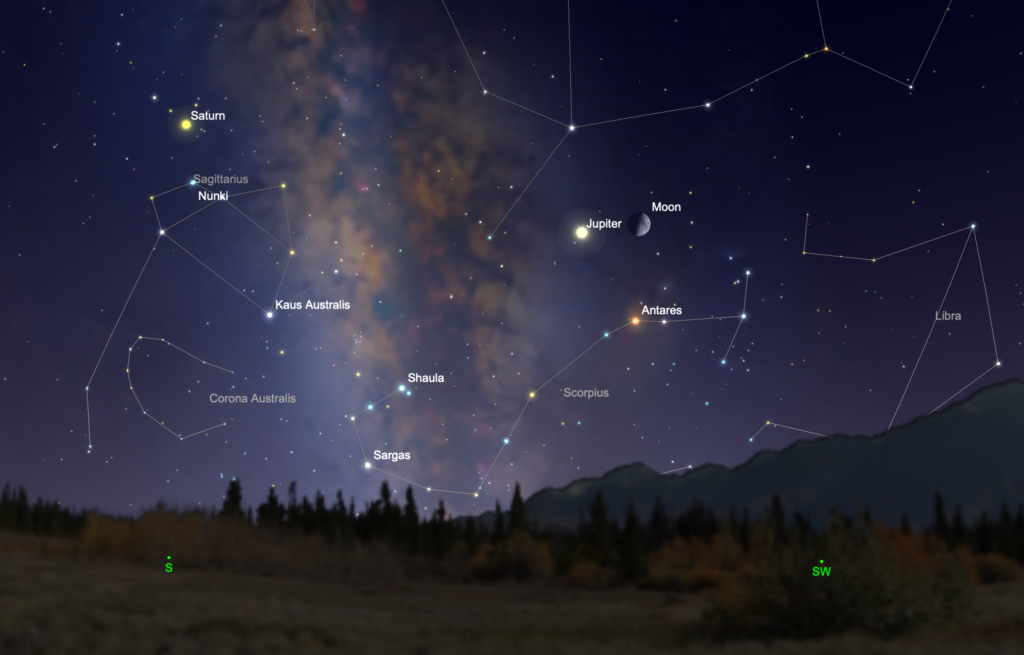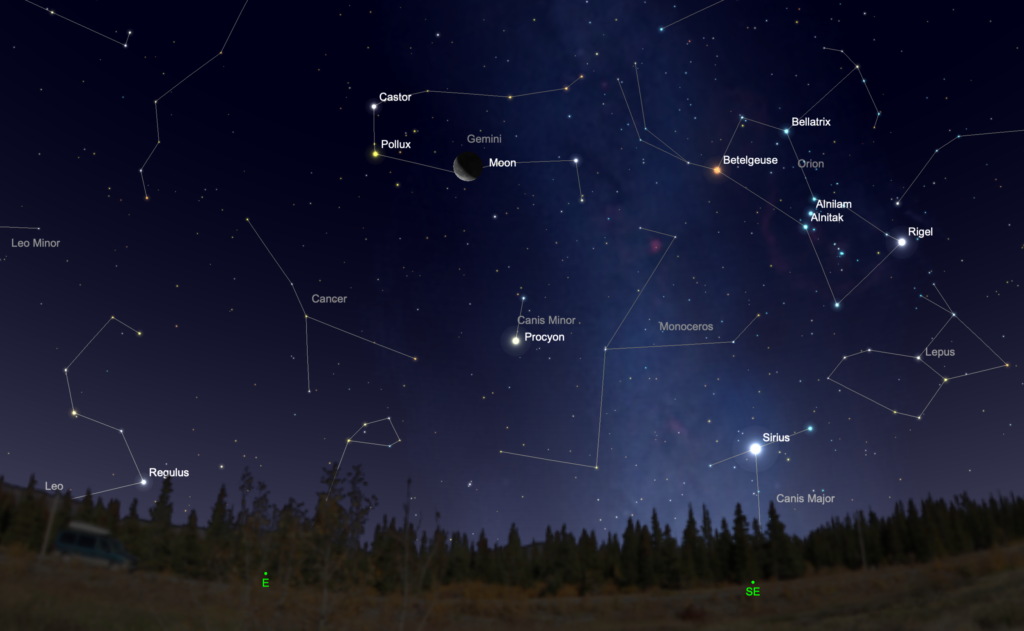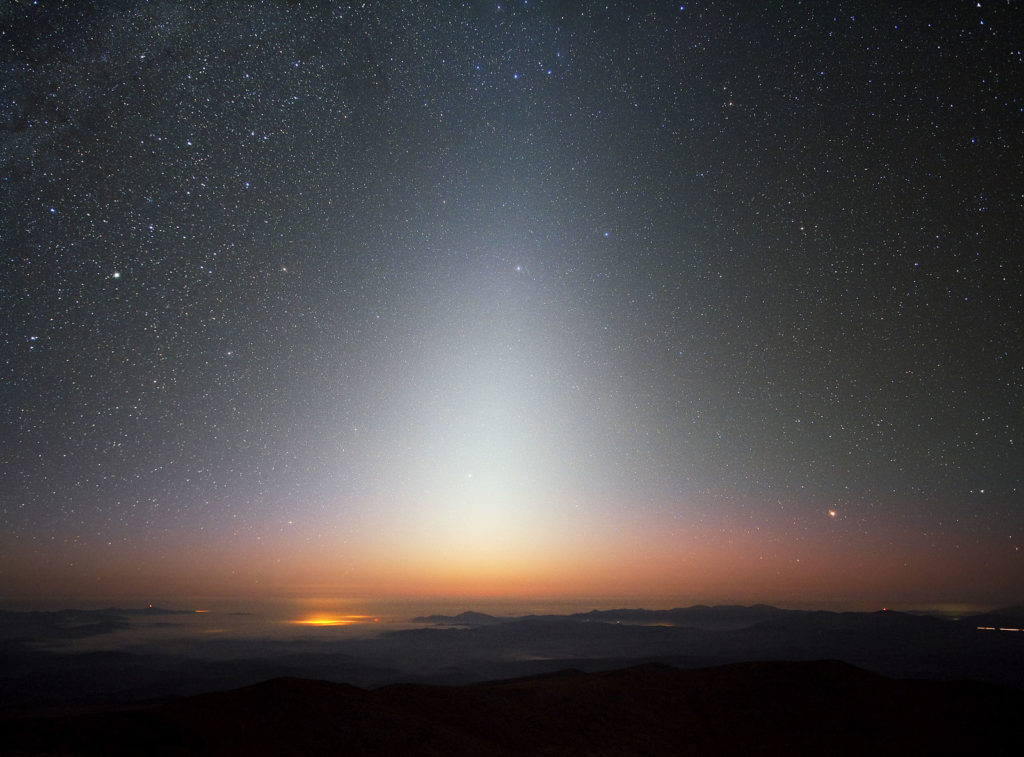
September has arrived, and that means stargazers have a final few weeks to see the long, starry arc of the Milky Way and all its attendant splendor. The rich constellations of Scorpius and Sagittarius are moving westward, but the lengthening nights keep these stars accessible for a little longer, at least for observers in the northern hemisphere. In the east, the relatively star-poor constellations of Pegasus, Capricornus, and Piscis Austrinus are moving into view along with hundreds of galaxies accessible with a small telescope. Also in September, Jupiter and Saturn linger in the southwest to liven up the sky, and the planet Neptune reaches opposition near a relatively bright star that makes it easy to see this most distant major planet. Here’s what to see in the night sky this month…
2 September 2019. Mars is in conjunction with the Sun. The planet remains on the far side of the Sun, lost in its glare, until late October when it slowly reemerges into the morning sky before sunrise.
4 Sept. Mercury reaches superior conjunction with the Sun and remains lost in the Sun’s glare until later in September.
5 Sept. After sunset, look for the first-quarter Moon and the bright planet Jupiter just north of the red-orange star Antares in the southwestern sky after sunset.

6 Sept. First Quarter Moon, 03:10 UT
8 Sept. Jupiter reaches eastern quadrature and lies precisely 90o east of the Sun. This geometry creates particularly dramatic shadows during eclipses and shadow transits of Jupiter’s four largest moons. (Sky & Telescope magazine has an online app to help you know when these events occur). The planet is well past opposition, but it still shines at an impressive magnitude -2.2 at the beginning of the month in the southwestern sky after sunset. The planet’s disk shrinks from an apparent diameter of 39” to 36” this month, but it’s still big enough to reveal appreciable detail on nights of good seeing. By the end of the month, the planet sets at about 10 p.m.

10 Sept. The planet Neptune reaches opposition, rising in the east as the Sun sets in the west. The planet is located in the constellation Aquarius, and today it’s less than a degree to the west of the red-orange star Phi (φ) Aquarii. At magnitude 7.8, this most distant planet is still relatively dim, but it’s easily visible in a telescope or binoculars. Detecting the 2”-wide disk of the planet is a little trickier: you will need a telescope at a magnification of 50x or more. Try a range of magnifications to see the disk of the planet change apparent size. This is still the best way to ensure you are seeing the planet and not the background stars, which do not change apparent size with magnification. The planet is best observed this month near or after midnight when it’s highest in the sky. Watch from night to night, before and after opposition, as the planet slowly changes its position relative to φ Aqr. The pale grey-blue of the planet contrasts nicely with the red-orange color of the star.
14 Sept. Full Moon, 04:33 UT
18 Sept. The planet Saturn is ‘stationary’, which means it ceases its retrograde westward motion and begins moving slowly eastward each day against the background stars. The planet’s located to the east of Jupiter near the handle of the “Teapot” of Sagittarius in the southern sky after sunset (and nearly overhead for southern-hemisphere observers). The planet fades to magnitude +0.5 by month’s end and sets about two hours after Jupiter. Saturn’s disk is small, but the planet’s rings are still glorious in a telescope with steady seeing.
22 Sept. Last Quarter Moon, 02:41 UT
23 Sept. At 07:50 Universal Time (UT), the Sun reaches the September equinox as it crosses the celestial equator moving south. This marks the beginning of autumn in the northern hemisphere and the beginning of spring in the southern hemisphere.

23 Sept. The waning crescent Moon forms a triangle with the bright stars Castor and Pollux in the constellation Gemini in the eastern sky before dawn. Several other bright constellations, including Orion and Canis Major, join the show
25 Sept. Look for bright Venus low over the western horizon after sunset. The planet has been lost in the glare of the Sun for several weeks, but it’s now emerging as the ‘Evening Star’ for the next many months.

26 Sept. Over the next couple of weeks, northern-hemisphere observers who have very dark sky can see the zodiacal light in the eastern sky about 90-120 minutes before sunrise in the northern hemisphere. This whitish glowing wedge of light appears to thrust upward from the horizon (see image above). The zodiacal light, sometimes called the “False Dawn”, is simply sunlight reflected off tiny dust particles in the inner solar system.
28 Sept. New Moon, 18:26 UT